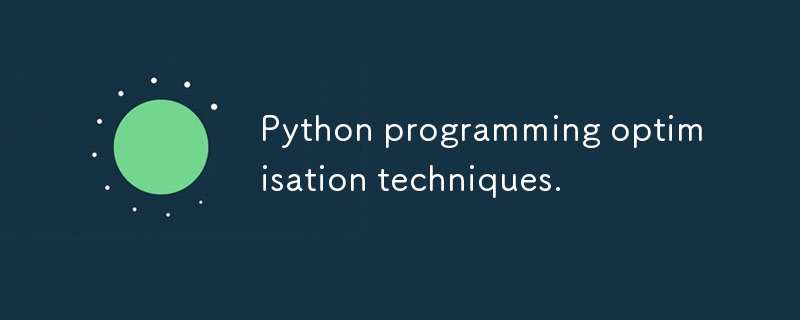

最適化されたコードはソフトウェアの効率、パフォーマンス、スケーラビリティに直接影響するため、不可欠です。適切に記述されたコードは、実行速度が速く、消費リソースが少なく、保守性が高いため、より大きなワークロードを処理し、ユーザー エクスペリエンスを向上させるのに適しています。また、効率的なコードには必要な処理能力とメモリが少なくなるため、運用コストも削減されます。これは、組み込みシステムや大規模なクラウド アプリケーションなど、リソースが限られた環境では特に重要です。
一方、コードの書き方が不十分だと、実行時間が遅くなり、エネルギー消費が増加し、インフラストラクチャのコストが増加する可能性があります。たとえば、Web アプリケーションでは、非効率なコードによりページの読み込みが遅くなり、ユーザー エクスペリエンスが低下し、ユーザーが離れていく可能性があります。データ処理タスクでは、非効率的なアルゴリズムにより大規模なデータセットの処理時間が大幅に増加し、重要な洞察や意思決定が遅れる可能性があります。
さらに、最適化されたコードは、多くの場合、保守や拡張がより簡単になります。最適化のベスト プラクティスに従うことで、開発者はコードベースをクリーンでモジュール化した状態に保つことができ、必要に応じてアプリケーションを更新したり拡張したりすることが容易になります。ソフトウェア プロジェクトが複雑になり、システムへの要求が増大するにつれて、これはますます重要になります。
より効率的でパフォーマンスの高いコードを作成するのに役立つ 10 の Python プログラミング最適化テクニックを見てみましょう。これらの手法は、パフォーマンス要件を満たしながら、長期間にわたって拡張性と保守性を維持できる堅牢なアプリケーションを開発するために不可欠です。これらのテクニックは、ベスト プラクティスに従うことで他のプログラミング言語にも適用できます。
変数パッキングは、複数のデータ項目を 1 つの構造にグループ化することでメモリ使用量を最小限に抑えます。この手法は、大規模なデータ処理など、メモリ アクセス時間がパフォーマンスに大きな影響を与えるシナリオでは重要です。関連データがまとめてパックされると、CPU キャッシュをより効率的に使用できるようになり、データの取得が高速化されます。
例:
import struct
# Packing two integers into a binary format
packed_data = struct.pack('ii', 10, 20)
# Unpacking the packed binary data
a, b = struct.unpack('ii', packed_data)
この例では、struct モジュールを使用して整数をコンパクトなバイナリ形式にパックし、データ処理をより効率的にしています。
ストレージ (ディスク) とメモリ (RAM) の違いを理解することは非常に重要です。メモリ操作は高速ですが揮発性であり、ストレージは永続的ですが低速です。パフォーマンスが重要なアプリケーションでは、頻繁にアクセスされるデータをメモリ内に保持し、ストレージ I/O を最小限に抑えることが速度を確保するために不可欠です。
例:
import mmap
# Memory-mapping a file
with open("data.txt", "r+b") as f:
mmapped_file = mmap.mmap(f.fileno(), 0)
print(mmapped_file.readline())
mmapped_file.close()
メモリマップされたファイルを使用すると、ディスクストレージをメモリのように扱うことができ、大きなファイルのアクセス時間が短縮されます。
固定長変数はメモリの連続ブロックに格納されるため、アクセスと操作が高速になります。一方、可変長変数は動的メモリ割り当てを管理するために追加のオーバーヘッドを必要とするため、特にリアルタイム システムでは操作が遅くなる可能性があります。
例:
import array
# Using fixed-length array for performance
fixed_array = array.array('i', [1, 2, 3, 4, 5])
# Dynamic list (variable-length)
dynamic_list = [1, 2, 3, 4, 5]
ここで、array.array は固定長の配列を提供し、動的リストよりも予測可能なパフォーマンスを提供します。
内部関数は、それが定義されているモジュール内でのみ使用されることを目的とした関数であり、多くの場合、速度と効率のために最適化されています。パブリック関数は外部使用のために公開されており、追加のエラー処理やログが含まれる場合があるため、効率が若干低下します。
例:
def _private_function(data):
# Optimized for internal use, with minimal error handling
return data ** 2
def public_function(data):
# Includes additional checks for external use
if isinstance(data, int):
return _private_function(data)
raise ValueError("Input must be an integer")
負荷の高い計算をプライベート関数に保持することで、コードの効率を最適化し、外部の安全性と使いやすさのためにパブリック関数を確保します。
Python では、デコレータは関数修飾子として機能し、関数のメイン実行の前後に機能を追加できます。これは、複数の関数呼び出しにわたるリソースの使用を最適化できる、キャッシュ、アクセス制御、ロギングなどのタスクに役立ちます。
例:
from functools import lru_cache
@lru_cache(maxsize=100)
def compute_heavy_function(x):
# A computationally expensive operation
return x ** x
lru_cache をデコレータとして使用すると、負荷の高い関数呼び出しの結果がキャッシュされ、冗長な計算が回避されてパフォーマンスが向上します。
ライブラリを活用すると、車輪の再発明を避けることができます。 NumPy のようなライブラリは C で書かれ、パフォーマンスを重視して構築されているため、純粋な Python 実装と比較して、大量の数値計算をはるかに効率的に実行できます。
例:
import numpy as np # Efficient matrix multiplication using NumPy matrix_a = np.random.rand(1000, 1000) matrix_b = np.random.rand(1000, 1000) result = np.dot(matrix_a, matrix_b)
Here, NumPy's dot function is enhanced for matrix operations, far outperforming nested loops in pure Python.
Short-circuiting reduces unnecessary evaluations, which is particularly valuable in complex condition checks or when involving resource-intensive operations. It prevents execution of conditions that don't need to be checked, saving both time and computational power.
Since conditional checks will stop the second they find the first value which satisfies the condition, you should put the variables most likely to validate/invalidate the condition first. In OR conditions (or), try to put the variable with the highest likelihood of being true first, and in AND conditions (and), try to put the variable with the highest likelihood of being false first. As soon as that variable is checked, the conditional can exit without needing to check the other values.
Example:
def complex_condition(x, y):
return x != 0 and y / x > 2 # Stops evaluation if x is 0
In this example, Python’s logical operators ensure that the division is only executed if x is non-zero, preventing potential runtime errors and unnecessary computation.
In long-running applications, especially those dealing with large datasets, it’s essential to free up memory once it’s no longer needed. This can be done using del, gc.collect(), or by allowing objects to go out of scope.
Example:
import gc # Manual garbage collection to free up memory large_data = [i for i in range(1000000)] del large_data gc.collect() # Forces garbage collection
Using gc.collect() ensures that memory is reclaimed promptly, which is critical in memory-constrained environments.
In systems where memory or bandwidth is limited, such as embedded systems or logging in distributed applications, short error messages can reduce overhead. This practice also applies to scenarios where large-scale error logging is necessary.
Example:
try:
result = 10 / 0
except ZeroDivisionError:
print("Err: Div/0") # Short, concise error message
Short error messages are useful in environments where resource efficiency is crucial, such as IoT devices or high-frequency trading systems.
Loops are a common source of inefficiency, especially when processing large datasets. Optimising loops by reducing iterations, simplifying the logic, or using vectorised operations can significantly improve performance.
Example:
import numpy as np # Vectorised operation with NumPy array = np.array([1, 2, 3, 4, 5]) # Instead of looping through elements result = array * 2 # Efficient, vectorised operation
Vectorisation eliminates the need for explicit loops, leveraging low-level optimisations for faster execution.
By applying these techniques, you can ensure your Python or other programming language programs run faster, use less memory, and are more scalable, which is especially important for applications in data science, web and systems programming.
PS: you can use https://perfpy.com/#/ to check python code efficiency.
以上がPython プログラミングの最適化テクニック。の詳細内容です。詳細については、PHP 中国語 Web サイトの他の関連記事を参照してください。